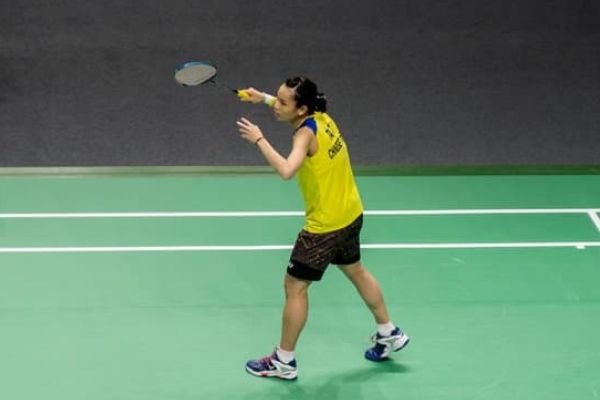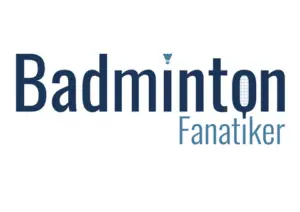It is really important to gain the first attack in a rally. If you are serving, you need to deliver the perfect serve. In one of the earlier articles, we discussed the various serves in Badminton. If you want to check it out, click here.
Now, let’s discuss how to return these serves when you are the receiver.
Remember, the first thing important while returning a serve is your stance.
Generally, you will have your legs bend with your non-dominant leg forward and your dominant arm raised to the level of your eye so that you are ready to hit the shuttle as quickly as possible. Your knees should be slightly bent so that you are ready to move in any direction.

Your opponent can serve a high, flick, low, or drive serve. You got to be half ready for a high serve and half ready for a low serve. Therefore, you’ve got to be ready to move aggressively backward or forward to receive and return the shuttle efficiently.
Let us now discuss how to return each type of serve specifically.
How To Return A High Serve In Badminton?
A high serve is executed when you want the shuttle to land at the back end of the court. The idea of a high serve is to move you away from your base position into the rear end of the court and also minimizes the chances of your attacking play. Does a thought come to your mind that if you are the receiver of a high serve, how will you return it?
Well, there are various ways in which you can return a high serve. However, your goal should be to control the rally or at least not give any advantage to the opponent.
Any short high serve that does not reach the rear end of the court is a gift and an opportunity to win a rally. You must be very careful with the shot you choose, as a wrong shot may lose you an advantage. The default return of a short high serve should be a smash. This will put your opponent under pressure and will serve as an advantage to you if your opponent is unable to receive the smash.
You can also hit a drop, but this can allow the opponent to reach the shuttle faster, which can be a disadvantage for you.
Assuming if you receive a good high serve then there are three shots you can use to return the service.
Smash
The first one is a smash. If you are a strong player who is comfortable with smashing, then you can go ahead with this shot. However, you must ensure that you can cover any likely returns from the opponent. You must also be aware that it takes longer to recover from a backcourt smash. Therefore, it’s better to aim at an angle and play the smash with a little less power.
Drop
The second shot is a drop. A slow drop from the rear end of the court spends more time in the air. This gives plenty of time for the opponent to decide their options. Therefore, a fast drop would be a better option. Also, using a bit of deception can delay the opponent in reaching the shuttle. Therefore, they will be forced to play a lift to recover.
Clear Shot
The third shot you can play is a clear shot. It can force your opponent to move to the rear end of the court, which gives you some time to recover. This is very important as recovering to your base position can give you time to think about your next best option.
We’ve learned how to return a high serve in badminton. Now, let’s see how we can return a low serve.
How To Return A Low Serve In Badminton?
A low serve is when you want to deliver the shuttle near the service line of the opponent. It is usually played in the men’s singles and doubles category. Considering that the shuttle moves just over the net, there are only two possible shots that you can return to your opponent. The shots are a net shot or a lift.
Net Shot
A net shot is the best option to use if you want to control the rally. However, you should be careful that your opponent can anticipate your net shot and aim to play a tight net shot in reply. This will possibly give them an advantage.
Despite this, there are several advantages to choosing a net shot option. It prevents a lift that could give an attack chance to your opponent. When you return a net shot, you can gain a lift which can allow you to attack. Using deception can give you an added advantage.
However, you must also be aware of your strengths and weakness. When playing a net shot as a return to a low serve, you must ensure that you can move to the rear end from this position. If not, your opponent will understand your weakness and will lift the shuttle to the rear end of the court.
Lift
Using a lift as a return to a low serve will give you time to return to your base position and prepare yourself for the next shot. However, make sure the lift is high and aimed towards the rear end of the court. It will also force the opponent to move to the rear end of the court. If the lift is good enough, the opponent will be unable to put some pressure on you.
If the lift is loose and low, it will give an attacking chance to your opponent.
One tip for a lift as a return is to aim it at the extreme backhand and forehand corners of the opponent. This increases the distance the opponent has to travel into their rear court from their base position.
Now, let’s see how we can return the flick of serve in the right way.
How To Return A Flick Serve In Badminton?
A flick serve is a deceptive serve played in the upward direction mostly in doubles. To return a flick serve, you must be able to travel to the back of the court as soon as possible.
So focus on transferring the weight from the front leg to the back leg and move backward hitting the shuttle with a jump. As you do not get much time to return the shuttle, lead with the elbow into a forearm rotation, and do not move your shoulder.
The shots with which you can return a shuttle can be a straight smash or a drop. Aim for an angle and hit the shuttle. Footwork and presence of mind are very essential to return a flick serve efficiently. Of course, never forget the saying, ‘Practice makes a man/woman perfect’.
How To Return A Drive Serve In Badminton?
A drive serve is a service that travels flat back to the back of the service court. To return a drive serve properly, you will need to practice receiving drive serves. One thing you need to keep in mind is to intercept drive serves immediately so that it does not get past you, forcing you to move backward.
For drive serves aimed at your backhand in your forehand service court, you will need to take your racquet arm behind your head to hit the shuttle. This is commonly known as the overhead shot.
The most common returns to a flat drive serve are a flat downward drive or a flat smash. These returns can make you a winner.
When you receive a higher drive serve, it can be either fast or slow. If it is slow, you will have time to jump back and up to intercept and return the serve.
You will need to respond to these serves in a mixed practice regime where the feeder can serve flick serves too. For the flick serve you must move back immediately, but for the drive serve you must stay intact. Don’t move before you see the shuttle.
Final Thoughts
If you’ve read this far and understood the basic concepts of returning different types of serves in badminton, it is time to put the things that you’ve learned into practice.
Do practice these returns as it will boost your confidence in real-time situations. Finally, do not become predictable with your return of serve. If you play the same pattern of returns, your opponent will reach the shuttle faster having predicted your shot.
I hope this article was helpful to you in improving your badminton knowledge. I would really appreciate it if you would be willing to share this article so that other people can find it.
Thanks for reading!
